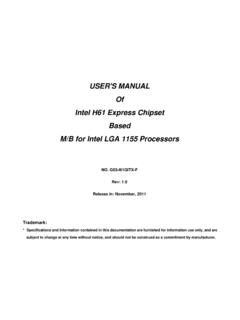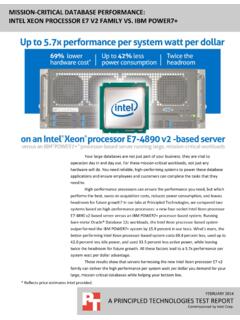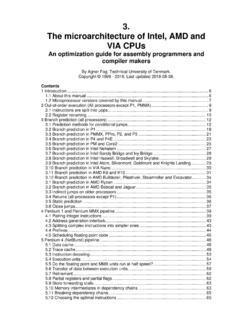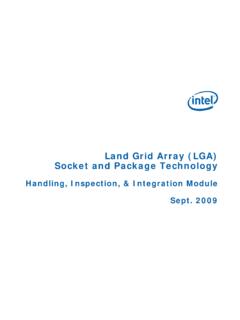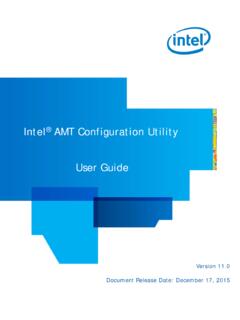Transcription of 4-Wire PWM Controlled Fans Specification
1 4-Wire Pulse Width Modulation (PWM) Controlled Fans Specification July 2004 Revision 2 INFORMATION IN THIS DOCUMENT IS PROVIDED IN CONNECTION WITH INTEL PRODUCTS. NO LICENSE, EXPRESS OR IMPLIED, BY ESTOPPEL OR OTHERWISE, TO ANY INTELLECTUAL PROPERTY RIGHTS IS GRANTED BY THIS DOCUMENT. EXCEPT AS PROVIDED IN INTEL S TERMS AND CONDITIONS OF SALE FOR SUCH PRODUCTS, INTEL ASSUMES NO LIABILITY WHATSOEVER, AND INTEL DISCLAIMS ANY EXPRESS OR IMPLIED WARRANTY, RELATING TO SALE AND/OR USE OF INTEL PRODUCTS INCLUDING LIABILITY OR WARRANTIES RELATING TO FITNESS FOR A PARTICULAR PURPOSE, MERCHANTABILITY, OR INFRINGEMENT OF ANY PATENT, COPYRIGHT OR OTHER INTELLECTUAL PROPERTY RIGHT.
2 Intel products are not intended for use in medical, life saving, or life sustaining applications. Intel may make changes to specifications and product descriptions at any time, without notice. The Intel Pentium 4 processor may contain design defects or errors known as errata which may cause the product to deviate from published specifications. Current characterized errata are available on request. Contact your local Intel sales office or your distributor to obtain the latest specifications and before placing your product order. Intel and the Intel logo are trademarks or registered trademarks of Intel Corporation or its subsidiaries in the United States and other countries. *Other names and brands may be claimed as the property of others. Copyright 2004, Intel Corporation 3 Contents 1 Introduction .. 7 7 2 Electrical Specifications.
3 9 Voltage .. 9 9 Tachometer Output Signal .. 9 PWM Control Input Signal .. 9 3 Fan Speed 11 Maximum Fan Speed 11 Minimum Fan Speed 11 Fan Speed Response to PWM Control Input Signal .. 12 Operation below Minimum 12 4 Required 17 Polarity 17 Rotor Lock Protection .. 17 Wire 17 Wire 17 Connector 17 Fan Connector Pinout and Wiring Colors .. 17 5 Environmental and 19 Operating Temperature .. 19 Non-operating Humidity .. 19 Non-operating Thermal Cycling .. 19 Power Cycling .. 19 19 6 Reference 21 4 Figures Figure 1 Minimum Fan Speed Requirements: Start Pulse .. 11 Figure 2 Fan Speed Response to PWM Control Input Signal.
4 12 Figure 3 Type A Operation, Minimum RPM, Stay on at Minimum 13 Figure 4 Type B Operation, Stay On at Minimum RPM, Off at 0% 14 Figure 5 Type C, Operation below Minimum RPM, Min, RPM = Starting 15 Figure 6 Connector Housing .. 22 Figure 7 Baseboard 23 Tables Table 1 Connector Pinout .. 17 5 Revision History Revision Number Description Revision Date Initial Internal Only June 2003 Initial Release Public Nov 2003 Corrected Tachometer input signal, added definitions to operating modes Dec 2003 Corrected Section PWM input parameter July 2004 6 Introduction 7 1 Introduction Overview This Specification defines the intended operation of a fan that implements the Pulse Width Modulation (PWM) control signal on the 4-Wire fan interface.
5 The introduction of 4 wire PWM Controlled fans is a means to reduce the overall system acoustics. The expectation is a 4 wire PWM Controlled fan when properly implemented will be significantly quieter than a similar 3 wire fan. Introduction 8 Electrical Specifications 9 2 Electrical Specifications Voltage Fan operating voltage shall be within the range 12 V V. Current Peak fan current draw during start-up operation (with V applied, with fan operating in the free stream condition) shall not exceed A.
6 Fan current spike during start-up operation (with V applied, with fan operating in the free stream condition) shall be allowed to exceed A for a duration of no greater than sec. Tachometer Output Signal Fan shall provide tachometer output signal with the following characteristics: Two pulses per revolution Open-collector or open-drain type output Motherboard will have a pull up to 12V, maximum PWM Control Input Signal The following requirements are measured at the PWM (control) pin of the fan cable connector: PWM Frequency: Target frequency 25 kHz, acceptable operational range 21 kHz to 28 kHz Maximum voltage for logic low: VIL = V Absolute maximum current sourced: Imax = 5 mA (short circuit current) Absolute maximum voltage level: VMax = V (open circuit voltage) Electrical Specifications 10 Fan Speed Control 11 3 Fan Speed Control Maximum Fan Speed Requirements The maximum fan speed shall be specified for the fan model by the vendor and correspond to 100% duty cycle PWM signal input.
7 Minimum Fan Speed Requirements The vendor shall specify the minimum RPM and the corresponding PWM duty cycle. This specified minimum RPM shall be 30% of maximum RPM or less. The fan shall be able to start and run at this RPM. To allow a lower specified minimum RPM, it is acceptable to provide a higher PWM duty cycle to the fan motor for a short period of time for startup conditions. This pulse should not exceed 30% maximum RPM and should last no longer than 2 seconds. See Figure 1. Figure 1 Minimum Fan Speed Requirements: Start Pulse Startup Pulse - Speed vs. (seconds)% of full speedMax % of full speed RPM for startupMax duration of startup pulse Fan Speed Control 12 Fan Speed Response to PWM Control Input Signal The PWM input shall be delivered to the fan through the control signal on Pin 4 (see Section ).
8 Fan speed response to this signal shall be a continuous and monotonic function of the duty cycle of the signal, from 100% to the minimum specified RPM. The fan RPM (as a percentage of maximum RPM) should match the PWM duty cycle within 10%. If no control signal is present the fan shall operate at maximum RPM. See Figure 2. Figure 2 Fan Speed Response to PWM Control Input Signal Speed vs. PWM Duty cycle01020304050607080901000 1020 3040506070 8090100PW M Duty Cycle of full speed specified RPM must be 30% or less (This example shows a minimum RPM of 20%) Operation below Minimum RPM For all duty cycles less than the minimum duty cycle, the RPM shall not be greater than the minimum RPM. The following graphs and definitions show three recommended solutions to handle PWM duty cycles that are less than the minimum operational RPM, as a percentage of maximum.
9 In a Type A implementation the fan will run at minimum RPM for all PWM duty cycle values less than minimum duty cycle. The minimum fan speed is Controlled by design and can not be overridden by the external fan speed controller. See Figure 3. Fan Speed Control 13 Figure 3 Type A Operation, Minimum RPM, Stay on at Minimum RPM Speed vs. PWM Duty cycle0510152025303505101520253035 PWM Duty Cycle Example of full speedThe fan stays on at minimum speed for all PW M duty cycle values below the minimum PWM duty cycle In a Type B implementation the fan will run at minimum RPM for all non-zero PWM duty cycle values less than minimum duty cycle and turn off the motor at 0% PWM duty cycle. See Figure 4. Fan Speed Control 14 Figure 4 Type B Operation, Stay On at Minimum RPM, Off at 0% RPM Speed vs.
10 PWM Duty cycle0510152025303505101520253035 PWM Duty Cycle % of full speed Example Example fan stays on at minimum speed for PWM duty cycle values below the minimum PWM duty cycle, and shuts off at 0% PWM duty cycle In Type C implementation the fan will stop running when the current provided to the motor windings is insufficient to support commutation. The fan should not be damaged from this. The fan would also turn off the motor at 0% PWM duty cycle input. See Figure 5. Fan Speed Control 15 Figure 5 Type C, Operation below Minimum RPM, Min, RPM = Starting RPM Speed vs. PWM Duty cycle0510152025303505101520253035PW M Duty Cycle Example Example of full speedThe minimum fan speed specified is also the minimum fan starting speed. The fan may continue to run at speeds below the minimum speed, but will not start at that speed as PW M duty cycle is being reducedFan speed as PW M duty cycle is being increased Fan Speed Control 16 Required Features 17 4 Required Features Polarity Protection Fan motor shall have polarity protection.
